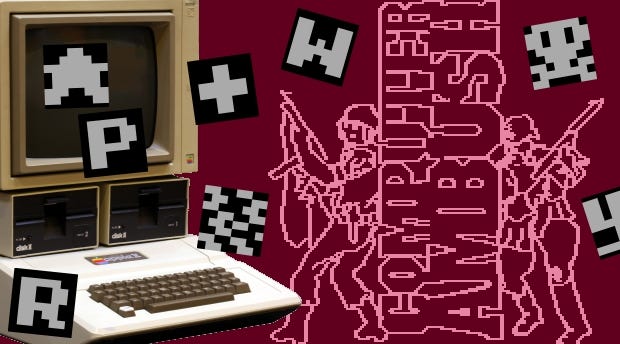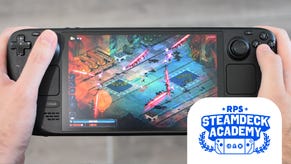The Flare Path: Is Computer Ambushed
"Soldier just screamed"
When Computer Ambush finally departs for that cherub-garrisoned VL in the sky, it can expect a star-studded send-off. If Close Combat, X-COM, Commandos, and Men of War aren't amongst the pallbearers, I'll be disappointed.
While the majority of his trailblazing contemporaries were focussing on naval skirmishes (limited computing power made wet warfare particularly attractive in the early days of PC wargame design) SSI's Ed Williger was bravely attempting to digitize squad-level WW2 urban combat. The result, Computer Ambush (1980), was flawed but breathtaking. Thirty-five years on, fighting your way through the game's shell-ravaged French town is still a bally exciting business.
No relation to the solitaire board wargame Ambush! that arrived a couple of years later, Williger's staggeringly ambitious design puts players in command of up to ten US or German soldiers. These soldiers have names and back stories. They have stats representing attributes like strength, intelligence, fitness, dexterity and weapons prowess. They can sprint, sneak, slither and scavenge. And, naturally, they know a thing or two about killing too. During nailbiting engagements rifles, carbines and MGs bark, grenades fly, blades flash, and garottes tighten around grimy throats. Though the action is communicated entirely through terse text narration and flashing 8x8 sprites, it takes precious little imagination to picture the desperate life-and-death struggles playing out amongst the rubble heaps and plaster-dusted furniture.
An inspired WeGo turn structure magnifies tension like a Zf-41 telescopic sight magnifies targets. At the start of every turn you decide how many Time Points (10 Time Points = 1 second) will pass before the next order opportunity. Once commands have been issued by both sides, results are calculated behind the scenes. While the cogitations are proceeding - a process that could take as long as three hours on the Apple II! - the computer teases with tantalising textual clues.
"Rifle was fired"
"MG was fired"
"Fragment grenade detonated"
"Soldier just screamed"
Like a pinned-down squad leader attempting to follow a firefight by listening to distant weapon reports and combatant cries, you peer at the messages, discerning what you can from their gnomic hints. Eventually the sums are done, the stream of stunted sentences stops, and it's time to watch the animated 'action review' on the map screen.
Bah, that busy rifle was a Kar98k... Splendid, that burst of MG fire was Bastinelli felling an SS man who was attempting to cross the street by the cafe... Knickers, that grenade blast was a potato masher exploding in the square between Padooka and Lawson.
Modern wargamers curious to try a title that was WeGoing decades before Combat Mission and simulating stealthy knife kills decades before Commandos: Behind Enemy Lines may find Computer Ambush's order mechanics a little disorientating at first. There's no mouse control. The game's diverse actions are queued up with pithy typed commands. To the uninitiated MR24RGFPFEF2432MR00FPRFA2099 might look like kitten-on-keyboard gibberish. To the experienced CA commander it's a queue of carefully considered actions that will cause a combatant to scamper 4 squares to the NE, pick up a grenade, hurl that grenade at a specific square (24,32), dive to the ground, ready his rifle and then glance around in search of targets of opportunity.
Within a few hours the shorthand will seem second-nature and you'll find yourself issuing some wonderfully precise and subtle orders...
MI39WFA5099
"Walk backwards down that street, only firing at targets if you've got at least a 50% chance of hitting them."
SBMR77WEP300SEMR37R
"Sneak into the alley opposite, place your plastic explosives against the back wall of the garage, setting a 300TT time delay, then leg it back the way you came."
WA99PBMR20SMR21RMR32RMR52RHH
"Get your breath back, fit bayonet, then stand up, rush into the barn, and melee the man in the SW corner."
It's amazing the dramas that can be triggered with a swift tippity-tap on the old word piano.
The command system needs to be powerful because a CA soldier without orders is a helpless statue. Friendly troops won't reload, run, turn or open fire without specific instructions. This lack of initiative together with the primitive graphics (there's no indication of soldier health, facing, weapon type, or order status on the map) mean careful monitoring and short turn durations are sensible during contacts. It's a reckless CO that leaves his or her warriors to their own devices for more than 50TP, or fails to check for unobserved wounds and exhaustion via the character stats screen every turn.
Williger clearly found the 48K Apple II a tad constraining. From his design notes...
"During the last six months I've learned the hard way the limitations of small computers and my own limitations in simulations. I think the game you have in your hands is a very good one, certainly worth playing often, and it should be a lot of fun. But honestly, folks, as soon as we all get a home Cray II computer... My original game had 30 different weapons, the map was 100 x 100 squares, there were prisoners, guards, medics, communications, campaign games, c-rations..."
With a bit more RAM and few more CPU cycles at his disposal I wonder if he would have attempted to model sound-based detection and morale. The game features remarkably sophisticated LoS mechanics, but the clomp of combat boots on cobbles never betrays a sprinting soldier; a hail of fire - while it may occasionally cause a target to duck out of sight for a few seconds - never triggers flight.
What calibre of AI did Computer Ambushers get for their $59.95? Well, choose to play against high stat SS men rather than 'Wehrmacht' or 'Volksgrenadier' opposition, and heed the squad-size advice in the scenario briefings, and you're guaranteed some close-run tussles. In defence artificial opponents doggedly refuse to quit their randomly determined spawn squares, and when patrolling or assaulting, they're probably not as keen on cover as they should be. However, a talent for grenade combat helps level/crater the playing field. The swastikas lurking in the accompanying screenshots are never happier than when chucking Stielhandgranates through windows or doorways. An experienced CA player seldom leaves engaged troops stationary for long.
The manual puts a positive spin on what today would be considered a rather slim scenario selection, proudly trumpeting that "Computer Ambush is actually 12 games in one". Of the five solitaire missions, one is little more than a tutorial and another, 'Ambush', is a turkey shoot unless you choose to play with a severely depleted squad. 'Raid' has the player assaulting a comms centre in the middle of the map. In 'Infiltration' a US patrol must reach a distant exit point with at least half its starting strength intact. 'Barn Defense' is the toughest of the outings thanks to a titular structure surrounded by cover and a force of fanatical attackers happy to set 000 time delays on their plastic explosives in order to secure victory.
The pic above shows a 'Raid' session in full swing. Bastinelli (B), top left, covered by Richfield (R) just below him, is dashing for the government building that houses the comms centre. Hoss (H), in the church on the right, has just pineappled an enemy machinegunner near the central statue, allowing his squad leader Padooka (P), across the square, to focus on the foe two squares to his SE. Should that foe survive a few squirts of close-range carbine fire, then the poor blighter will have to face Lawson (L), currently sprinting across an alley SW of Padooka with bayonet fixed. Cheng (C), Garrity (G) and Wheelock (W), the three men on the far right? All dead or incapacitated, sadly. Stick grenades thrown from the government building and hedge corner on column 38 have taken a terrible toll on that side of the map.
Customised loadouts and randomly generated squad stats and enemy spawn locations, inject variety into the single-player missions. They also enrich Computer Ambush's utterly marvellous hotseat duels. While a few solo CA sessions (perhaps courtesy of the Internet Archive's embedded emulator) are sure to leave you full of admiration for Ed Williger's landmark wargame, to experience this pioneer at its nerve-fraying best you really need to play against a live opponent. Those perfectly timed plastic explosives detonations, brutal bayonet kills and unexpected garottings... all infinitely more satisfying when inflicted on an opponent adept at perfectly timed plastic explosives detonations, brutal bayonet kills and unexpected garottings.
***************************************************************
The Flare Path Foxer
Last week's collage was steeped in gin for several days prior to publication. The finely-tuned schnoz of Rorschach617 recognised this fact after helpful bouquet breakthroughs from the likes of AFKAMC, FuryLippedSquid, Shiloh, Stugle, and mrpier. Phlebas, Dropzone, Llewyn and Grizzly then nosed around naming missing botanicals.
(theme: gin)
a London Gin
b Gin Lane
c Bombay gin
d Plymouth gin
e Juniper
f Martini
g Bathtub gin
h Gin Palace
i Gin trap
j Gordon's Gin
***************************
Was the Battle of Waterloo really won on the playing fields of Eton? I suspect not, but June 12's foxer was definitely lost there.
(theme: Eton wall game and Eton field game)
a WALL-E screenshot
b Pe-8
c Agar Gun (Agar's Plough is a field game venue)
d Flying Dutchman stamp (Dutchman's is a field game venue)
e Bully shortcut (A bully is a scrum-like formation in both the wall and field game)
f Shirley Eaton
g Khmer Rouge banknote (A rouge is the field game's version of a try)
h Ram tank (The ram is a field game formation)
i Prince Harry (Once an Eton wall and field game player)
j SE5.A belonging to Arthur Rhys-Davids (The WWI air ace played both games)
k Phalanx board (Board game and wall game formation)
***************************
Foxer Fact #219
After the British Library banned defoxers from its reading room in May 1924, a group of the excluded led by Winston Churchill's uncle, Naismith Churchill, broke into the building - then part of the British Museum - and released a dozen live foxes. The beasts proved extremely hard to catch. By 1939 there were said to be over 500 bushy-tailed den-diggers living amongst the bookshelves and desks. A post-war gassing programme eventually ended the infestation.
All answers in one thread, please.























